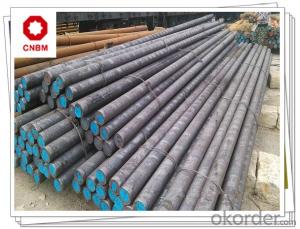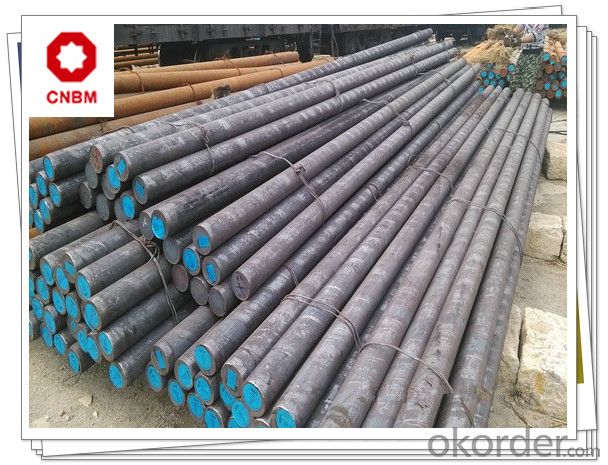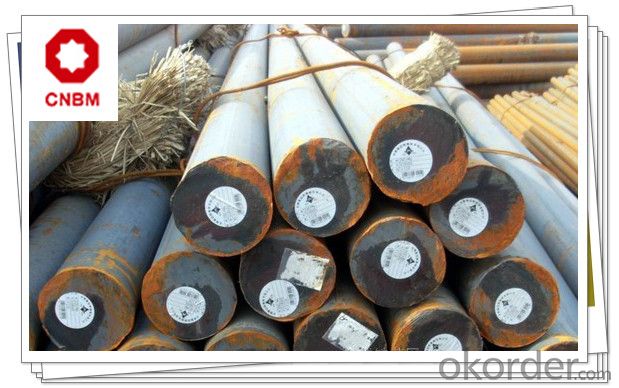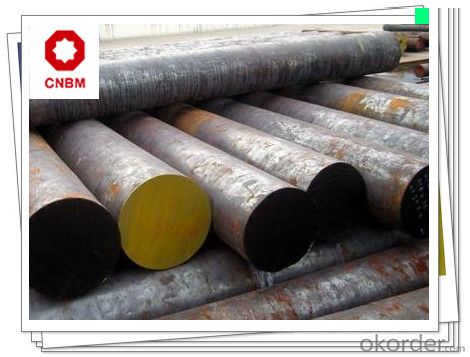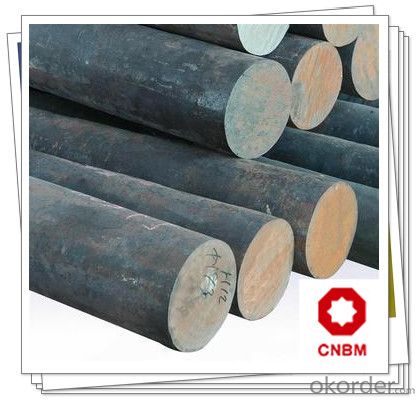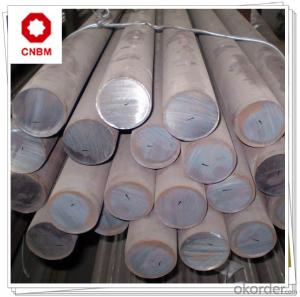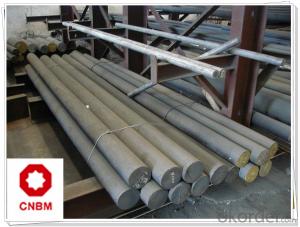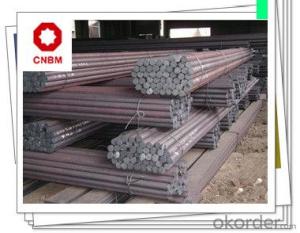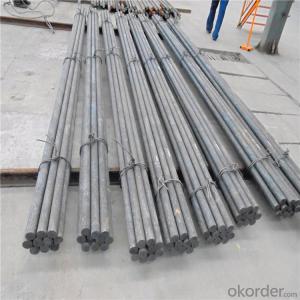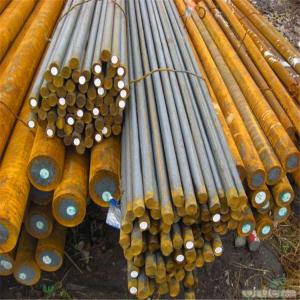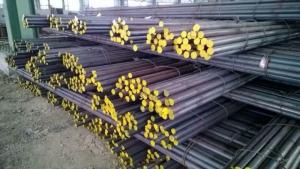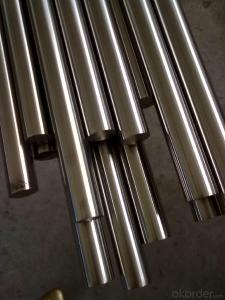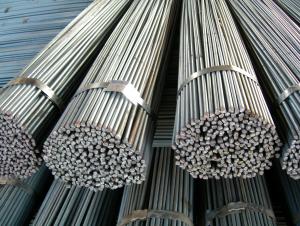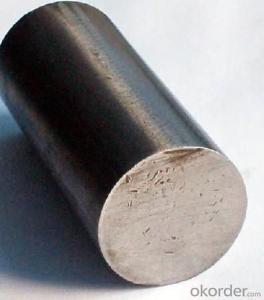Hot Rolled Carbon Steel Round Bars S30C
- Loading Port:
- Shanghai
- Payment Terms:
- TT OR LC
- Min Order Qty:
- 50 m.t.
- Supply Capability:
- 120000 m.t./month
OKorder Service Pledge
OKorder Financial Service
You Might Also Like
Hot Rolled Carbon Steel Round Bars S30C
Product Specification
1, Chemical Composition %
| Grade | C | Si | Mn | S | P | Cr | Ni | Cu |
| S30C | 0.27-0.34 | 0.17-0.37 | 0.50-0.80 | ≤0.035 | ≤0.035 | ≤0.25 | ≤0.30 | ≤0.25 |
2, Diameter: 16mm - 300mm
Length: Max 12m
Application
1, Used as mending of drawing parts of automobile sheet metal die and large hard ware sheet metal die.
2, Used as base plate of cold working die.
3, Used as fix plate of drill jig.
Product Main Points
1, Heat Treatment: normalizing, annealing, tempering, quenching
2, Surface Treatment: black, grinding, bright, polish
3, Product Process: hot rolled, cold drawn, forged
FAQ
1, Payment Terms:
30% T/T deposit & 70% T/T before delivery.
Irrevocable L/C at sight
2, Trade Terms:
EXW, FOB, CIF, CNF
3, Delivery Time:
Normally 30-40 days. According to quantity.
4, Manufacture or Trading Company:
CNBM is a state-owned fortune global 500 trading company. We have intergrated supply system.
There are about 20 overseas locations in different countries.
Product Show
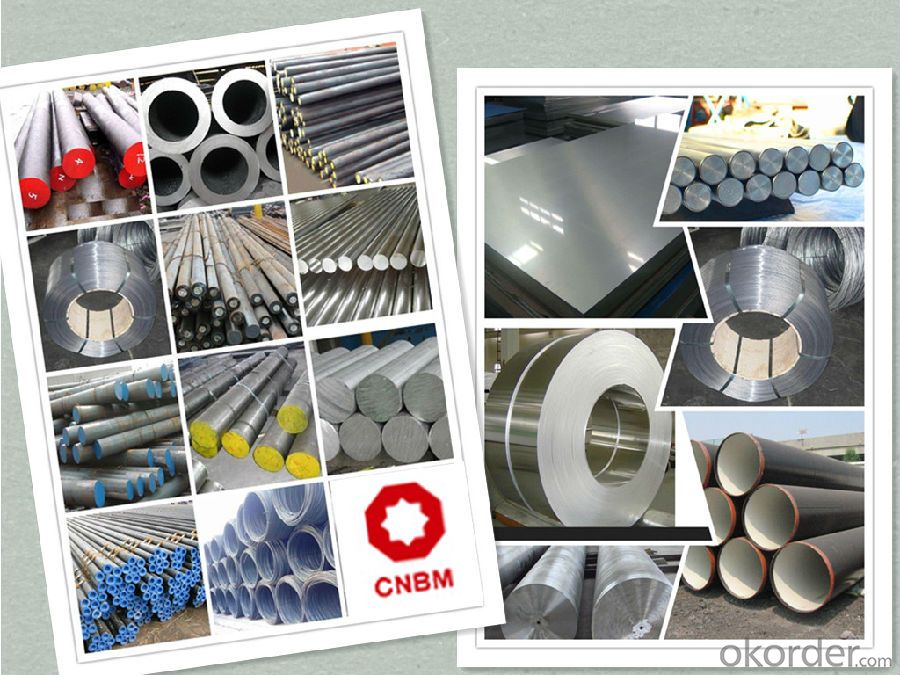
Work Shop
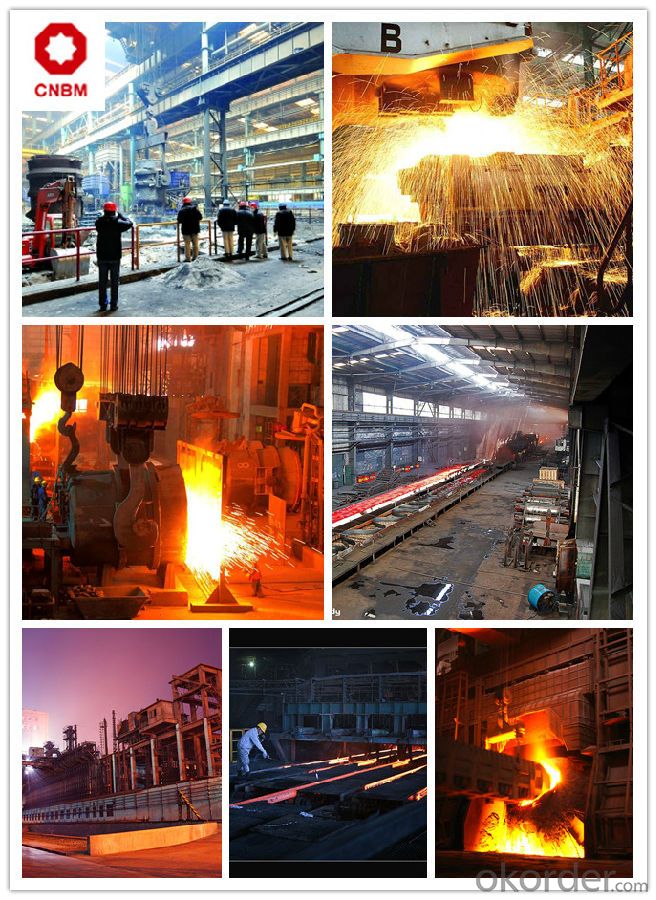
About Us

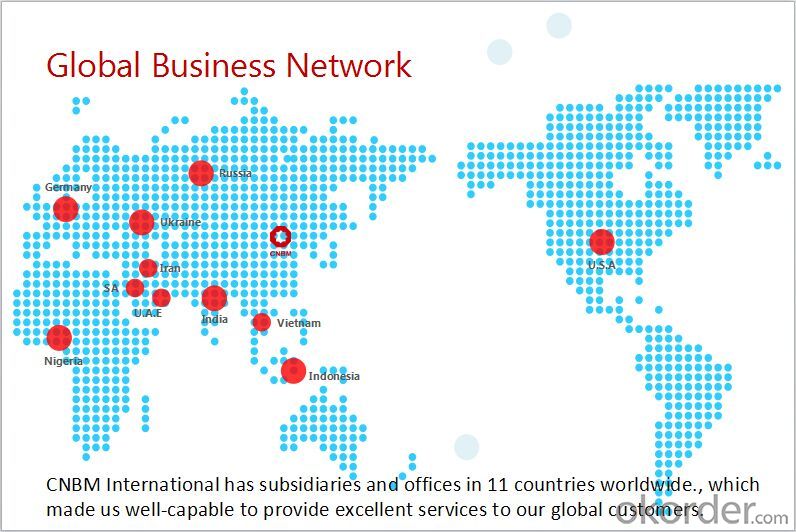
- Q: What are the different types of steel used in manufacturing round bars?
- Round bars in manufacturing can be made from various types of steel. The most commonly used types include: 1. Carbon Steel: This is the go-to steel for manufacturing round bars due to its strength and durability. It mainly consists of iron and carbon and finds application in construction, automotive, and machinery. 2. Alloy Steel: By adding elements like manganese, nickel, chromium, and molybdenum to carbon steel, alloy steel is formed. This enhances its strength and hardness, making it suitable for applications that demand high strength and resistance to wear and tear. 3. Stainless Steel: A type of alloy steel, stainless steel contains a minimum of 10.5% chromium. This high chromium content gives it excellent corrosion resistance, making it ideal for applications exposed to moisture or chemicals. Stainless steel round bars are commonly used in kitchen utensils, medical equipment, and automotive parts manufacturing. 4. Tool Steel: Tool steel is an alloy steel designed specifically for high hardness, wear resistance, and heat resistance. It is commonly used in manufacturing cutting tools, dies, and molds. Tool steel round bars are usually made from high-carbon steel with additional elements like tungsten, vanadium, or cobalt. 5. Bearing Steel: Bearing steel is an alloy steel specifically formulated for bearing applications. It is characterized by its high hardness, wear resistance, and fatigue strength. Bearing steel round bars are widely used in bearing manufacturing for industries like automotive, aerospace, and industrial machinery. These examples demonstrate the range of steel types available for manufacturing round bars. The specific choice of steel depends on the desired properties and requirements of the application at hand.
- Q: What is the maximum weight that can be lifted using a steel round bar as a lifting rod?
- The lifting capacity of a steel round bar depends on several factors, including its diameter, length, material composition, and lifting technique. Different steel round bars have different load-bearing capacities based on their dimensions and grade. Engineering principles and specific formulas can be used to calculate the load-bearing capacity of a steel bar based on its material and geometry. To determine the maximum weight that can be lifted with a particular steel round bar, it is important to consider its ultimate tensile strength, yield strength, and factor of safety. The ultimate tensile strength represents the maximum stress the material can handle before failure, while the yield strength is the stress at which permanent deformation occurs. The factor of safety is a design parameter that takes uncertainties into account and ensures structural integrity. To obtain accurate and reliable information about the load-bearing capacity of a specific steel round bar, it is crucial to consult engineering references, standards, or professionals. They can provide the necessary calculations, considering the bar's diameter, length, material properties, intended lifting application, and safety requirements. In conclusion, the maximum weight that can be lifted using a steel round bar as a lifting rod depends on various factors and cannot be determined without considering the specific characteristics of the bar and the lifting scenario. Consulting engineering resources or experts is essential to ensure safe and accurate calculations.
- Q: What are the advantages of using nickel-molybdenum-vanadium alloy steel round bars?
- There are several advantages of using nickel-molybdenum-vanadium alloy steel round bars, including: 1. High strength and durability: Nickel-molybdenum-vanadium alloy steel round bars offer excellent strength and durability, making them suitable for applications that require a high level of structural integrity. This alloy steel is known for its ability to withstand heavy loads and resist deformation, making it ideal for use in industries such as construction, automotive, and aerospace. 2. Corrosion resistance: Another advantage of using nickel-molybdenum-vanadium alloy steel round bars is their excellent resistance to corrosion. The addition of nickel and vanadium to the alloy enhances its ability to resist oxidation and corrosion, even in harsh environmental conditions. This makes it a preferred choice for applications where exposure to moisture, chemicals, or corrosive substances is expected. 3. Heat resistance: Nickel-molybdenum-vanadium alloy steel round bars have a high heat resistance, making them suitable for applications that involve high temperatures. The presence of molybdenum in the alloy increases its resistance to thermal stress, ensuring that it remains structurally stable even at elevated temperatures. This makes it ideal for use in industries such as oil and gas, power generation, and heat exchangers. 4. Versatility: The versatility of nickel-molybdenum-vanadium alloy steel round bars is another advantage. This alloy can be easily forged, machined, and welded, allowing for a wide range of manufacturing processes. Its versatility makes it a preferred choice for applications that require complex shapes and designs, such as shafts, gears, and valves. 5. Cost-effective: Despite its numerous advantages, nickel-molybdenum-vanadium alloy steel round bars are relatively cost-effective compared to other high-performance alloys. Its excellent combination of properties makes it a cost-efficient option for various industries, as it offers a longer lifespan, reduced maintenance requirements, and improved performance, ultimately resulting in cost savings over time. In conclusion, the advantages of using nickel-molybdenum-vanadium alloy steel round bars include high strength and durability, corrosion resistance, heat resistance, versatility, and cost-effectiveness. These properties make it a preferred choice for a wide range of applications in various industries.
- Q: What are the different grades of alloy steel round bars?
- Alloy steel round bars come in various grades, each with unique properties and characteristics. Some of the different grades of alloy steel round bars include: 1. 4140: This grade of alloy steel round bar is known for its high strength, toughness, and abrasion resistance. It is commonly used in applications such as axles, shafts, and gears. 2. 4340: This grade of alloy steel round bar is known for its excellent hardenability and high tensile strength. It is often used in applications that require high strength and durability, such as aircraft landing gear components and crankshafts. 3. 8620: This grade of alloy steel round bar is known for its case hardening properties, making it suitable for applications that require a combination of toughness and wear resistance. It is commonly used in gears, pinions, and camshafts. 4. 316: This grade of alloy steel round bar is a stainless steel grade that offers excellent corrosion resistance, making it suitable for applications in marine environments or where exposure to corrosive substances is a concern. 5. 52100: This grade of alloy steel round bar is known for its high hardness and wear resistance. It is commonly used in the manufacturing of bearings and other high-wear components. 6. 4340M: This grade of alloy steel round bar is similar to 4340, but with added molybdenum for improved hardenability and strength. It is often used in applications that require high strength and toughness, such as aircraft landing gear components and crankshafts. These are just a few examples of the different grades of alloy steel round bars available. The choice of grade will depend on the specific requirements of the application, such as desired mechanical properties, corrosion resistance, and heat treatment capabilities.
- Q: What are the advantages of using wear-resistant steel round bars?
- There are several advantages of using wear-resistant steel round bars: 1. Enhanced durability: Wear-resistant steel round bars are specifically designed to withstand high levels of abrasion and wear. They have a high hardness level and are resistant to surface damage caused by friction, impact, or scraping. This results in a longer lifespan of the round bars, reducing the need for frequent replacements. 2. Increased strength: Wear-resistant steel round bars possess exceptional strength properties, allowing them to withstand heavy loads and extreme conditions. This makes them suitable for a wide range of applications, such as in industries like mining, construction, manufacturing, and transportation, where strength and resilience are crucial. 3. Improved safety: The use of wear-resistant steel round bars ensures a safer working environment. Their high resistance to wear minimizes the risk of accidents and injuries caused by equipment failures or structural damage. This is particularly important in industries where heavy machinery, tools, or structures are involved. 4. Cost-effectiveness: Although wear-resistant steel round bars may have a higher initial cost compared to regular steel bars, their extended lifespan and reduced maintenance requirements make them a cost-effective choice in the long run. The reduced need for replacements and repairs leads to lower downtime, increased productivity, and ultimately, decreased operational costs. 5. Versatility: Wear-resistant steel round bars can be used in a variety of applications due to their versatility. They can be easily machined, welded, or formed into different shapes and sizes to meet specific requirements. This flexibility allows for their use in various industries and applications, making them an ideal choice for many projects. In summary, the advantages of using wear-resistant steel round bars include enhanced durability, increased strength, improved safety, cost-effectiveness, and versatility. These properties make them a reliable and efficient option for applications where wear and tear are significant concerns.
- Q: Can steel round bars be used for making shock absorber components?
- Yes, steel round bars can be used for making shock absorber components. Steel is a common material choice for shock absorber components due to its strength, durability, and ability to withstand high levels of stress and impact. The round shape of the bars also allows for easy machining and fabrication of the necessary components.
- Q: Can steel round bars be bent or formed?
- Steel round bars have the capability to be bent or formed, depending on several factors such as the type of steel, bar diameter and thickness, and the chosen bending or forming method. There are various techniques available for bending or forming steel round bars, including hot bending, cold bending, and mechanical bending. In hot bending, the steel round bar is heated to a specific temperature and then shaped according to the desired form. On the other hand, cold bending does not require any heating and can be accomplished using hydraulic or manual bending machines. Mechanical bending, however, involves the utilization of specialized machinery to apply force and bend the steel round bar. It is vital to note that excessive bending or forming may weaken the steel round bar and affect its structural integrity. Hence, it is crucial to adhere to proper bending and forming techniques and consider the manufacturer's limitations and industry standards.
- Q: Can steel round bars be used for making bearings?
- Steel round bars can indeed be used for making bearings. However, it is important to note that the specific type of steel used, as well as the manufacturing process, play a crucial role in determining the suitability of steel round bars for bearing applications. Bearings are typically subjected to high loads and require good wear resistance, low friction, and high durability. Steel round bars made from high-quality alloy steels, such as chrome steel or stainless steel, are commonly used for bearing manufacturing due to their excellent mechanical properties. These steel round bars undergo specific heat treatment processes, such as quenching and tempering, to enhance their hardness, strength, and wear resistance. Additionally, the round bars are typically machined to precise tolerances to ensure proper fit and alignment within the bearing assembly. It is important to consult with materials and manufacturing experts or refer to industry standards to ensure the appropriate steel round bar material and manufacturing processes are used for bearing applications. This will ensure the best performance, reliability, and longevity of the bearings in various operating conditions.
- Q: What are the different types of steel round bar shapes?
- There are several different types of steel round bar shapes, including solid round bars, hollow round bars, threaded round bars, and precision ground round bars.
- Q: Can steel round bars be used in the construction of bridges?
- Yes, steel round bars can definitely be used in the construction of bridges. Steel round bars are commonly used in bridge construction due to their high strength, durability, and versatility. They offer excellent load-bearing capabilities and can withstand heavy loads, making them suitable for use in bridge beams, columns, and other structural elements. Additionally, steel round bars can be easily welded, bent, and formed into various shapes and sizes, allowing for customized designs and efficient construction processes. The use of steel round bars ensures the structural integrity and longevity of the bridge, making them a popular choice in bridge construction worldwide.
Send your message to us
Hot Rolled Carbon Steel Round Bars S30C
- Loading Port:
- Shanghai
- Payment Terms:
- TT OR LC
- Min Order Qty:
- 50 m.t.
- Supply Capability:
- 120000 m.t./month
OKorder Service Pledge
OKorder Financial Service
Similar products
Hot products
Hot Searches
Related keywords
